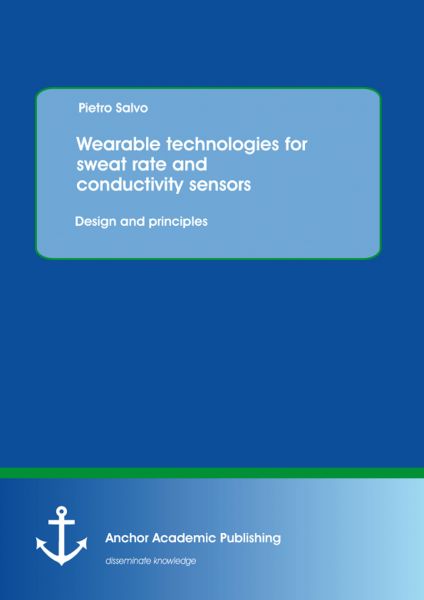Wearable technologies for sweat rate and conductivity sensors: design and principles
Wearable sensors present a new frontier in the development of monitoring techniques. They are of great importance in sectors such as sports and healthcare, as they permit the continuous monitoring of physiological and biological elements, such as ECG and human sweat. Until recently, this could only be carried out in specialized laboratories in the presence of cumbersome, and usually, expensive devices. Sweat monitoring sensors integrated onto textile substrates are not only part of a new field of work but, they also represent the first attempt to implement such an innovative idea on a system which will be worn directly on the body. The objective of this book is to present possible designs and technologies of low cost wearable sweat rate and conductivity sensors integrated onto a textile. The first chapter deals with a preliminary introduction on sweat production and composition, and the applications of wearable devices. Further, the second chapter describes the conductivity sensor, i.e. the geometry, materials and the coupling which includes a temperature sensor for precise measurements are discussed. This is followed by a chapter on the sweat rate sensor, and the technologies employed to fabricate it. Sensors that are based on a) conductive yarns coated with hydrophilic polymers, b) conductive polymer fibres, c) hydrophilic polymers between conductive fabrics and d) humidity sensors are described in detail. Finally, the last chapter provides a study of sweat production in different body areas, the calibration procedure, and summarizes the results which arise from the tests on volunteers.
Text Sample:
Chapter 1.4, Market innovation analysis and level of innovation.
The market is not only ready for the diffusion of wearable sensors but demand is also increasing. Smart fabrics and interactive textiles (SFITs) are likely to exceed $ 640 US million by the end of 2008. Moreover, the compound annual growth rate (CAGR) was about 27% in the period 2004-2008.
According to BCC Research in 2007, the US market for smart textiles alone was worth about $ 79 million. Sales of conductive fabric products are expected to more than double each year through 2012, when the market is expected to reach $ 392 million.
BCC expects rapid growth in military, health care, vehicle safety and comfort applications, thus leading to a greater impact of wearable sensors in the global market for sensors. Very few products that were designed to monitor health have reached the market, but significant amounts of money are being invested in this technology. Most of the products already available were designed for use by athletes.
Lifeshirt, manufactured by Vivometrics, was designed for respiratory monitoring and other physiological signals, such as heart rate, EEG, EOG. Users have to wear a cap and a thimble in order to have their EEG/EOG and blood oxygen saturation monitored, respectively. Lifeshirt correlates and makes indirect measurements to obtain blood pressure, body temperature, periodic leg movement, and end tidal CO2. In any case, its use is limited to research and military centres.
Sensatex, a U.S. company, is working on a Smart Textile Technology and on the SmartShirt System, which should be able to measure and/or monitor heart rate, respiration rate, body temperature, caloric burn, body fat, and UV exposure.
Wealthy is a system by Smartex, an Italian company, able to acquire physiological parameters like ECG, posture and temperature.
The most common products available are for heart monitoring by Polar, Reebok or Mio™, pedometers and pulse meters manufacture by, for example, Oregon Scientific and for diabetes monitoring such as GlucoWatch®, which shows glucose levels in blood.
The development of a wearable sensor, which can be integrated into textiles, for sweat analysis is a complete breakthrough. This book is, in fact, one of the first attempts to correlate electrophysiological data with biochemical information.
The results should provide lead to a more effective system than any other currently on the market. At present, to the best of our knowledge there is no product on the market that can perform multiple physiological measurements using a portable wireless system.
Furthermore, although there are some devices that can monitor some physiological parameters, there are no chemical wearable sensors currently available.
This point needs emphasizing since it represents the most important strength of the project, providing a new useful non-invasive instrument and technique for trainers, doctors, patients and users.
Protection, safety, health and also fashion are sectors which will be greatly influenced by wearable sensors and it is certainly not farfetched to imagine a future where our life will be regulated by these new sensors.
Pietro Salvo obtained the M.Sc. degree in electronic engineering in 2004, and thereby, he specialized in biomedical science. In 2009, he obtained the Ph.D. in Automation, Robotics and Bioengineering from the University of Pisa, in Italy. From 2008 until 2009, he worked as a research associate at the Institute for the Conservation and Promotion of Cultural Heritage at the National Council of Research, in Florence, Italy. Currently, the author is a post-doctoral researcher at the Centre for Microsystems Technology (CMST) at the University of Ghent, in Belgium where he has been part of since 2009. The author’s research interests mainly include bioengineering and biomedical applications.
Versandkostenfreie Lieferung! (eBook-Download)
Als Sofort-Download verfügbar
- Artikel-Nr.: SW9783954895373
- Artikelnummer SW9783954895373
-
Autor
Pietro Salvo
- Wasserzeichen ja
- Verlag Anchor Academic Publishing
- Seitenzahl 83
- Veröffentlichung 01.06.2013
- ISBN 9783954895373

